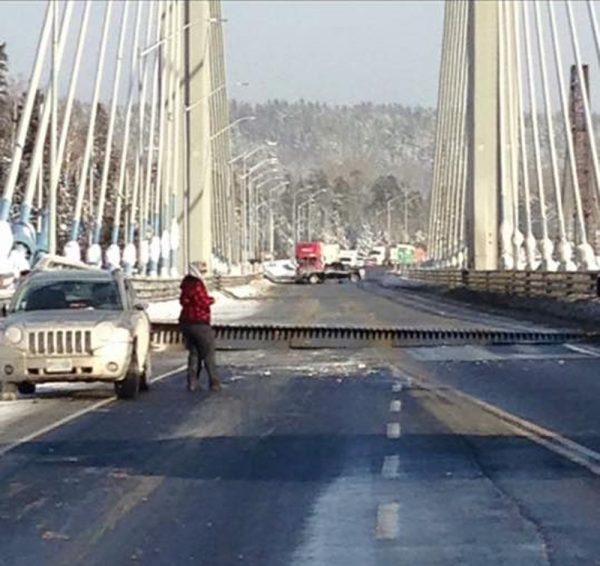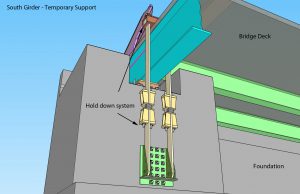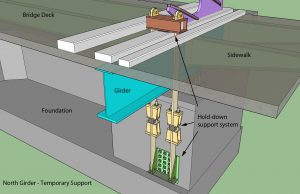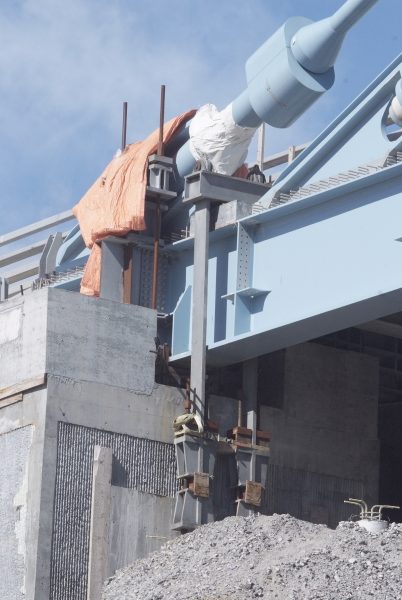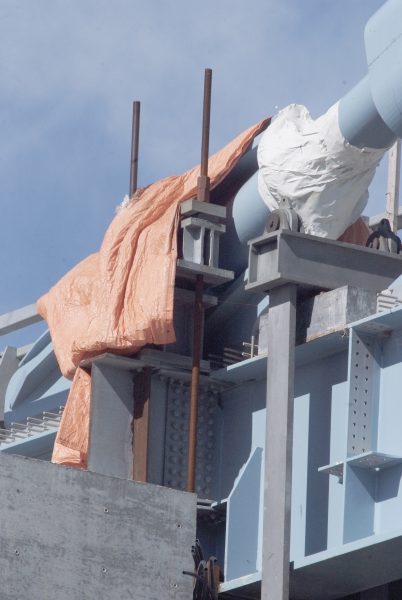Oct 24, 2016 @ 08:49
The Nipigon River Bridge failed dramatically – the western side rose 60 centimeters midafternoon on January 10, 2016, and was closed immediately by Nipigon Ontario Provincial Police. An estimated 200 metric tons (200 long tons; 220 short tons) of concrete jersey barriers were placed on the deck to hold it down, and the bridge reopened to one-lane, escorted traffic the next day. 24-hour monitoring of the bridge joints and bearings continued while repairs were underway. The bridge had failed after only 42 days in operation. Thankfully, there were no injuries.
|
|
|
|
|
|
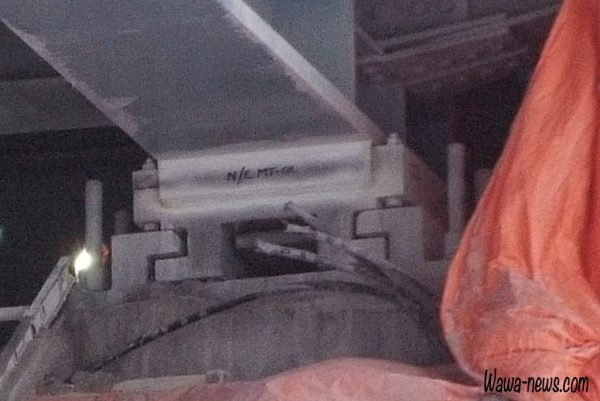
North Girder – “This picture shows the existing bearing system. This is not the new system that is being installed. (MTO)” – this is now titled the ‘north-west’ bearing by Associated Engineering.
On February 25th, 42 days later, the bridge was reopened to full traffic – a new temporary support (above), a new hold-down system had been installed and the jersey barriers removed, without any explanation as to what exactly went wrong. This new “temporary repair”, “Primary temporary repair”, “Temporary repair system”, “Hold-down support system” has it has been termed in various reports, was reviewed by Associated Engineering, and no concerns were found. Photo to the right shows the existing bearing system as photographed in February.
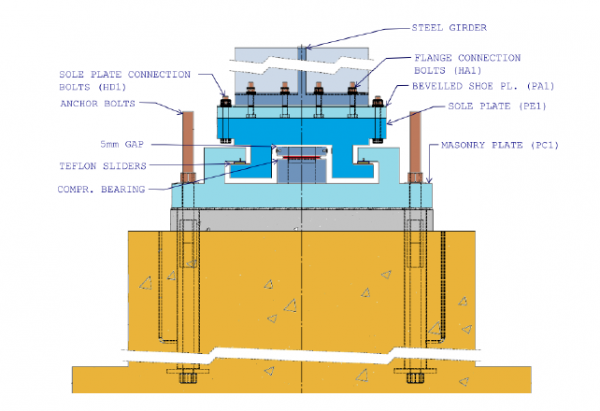
Figure 1-3: Bearing Nomenclature (from Ministry of Transportation – Nipigon River Bridge Independent Technical Review by Associated Engineering).
In the meantime, attention was being focussed on the bolts that failed. Bolts were sent to the National Research Council of Canada in Ottawa and Surface Science Western at Western University for testing. When the results of testing were released on July 4th, 2016 some things became clear. However, the MTO updates on the Nipigon Bridge said, “The bolt study provided us with only a partial answer about the bridge, and as such we think it’s premature to discuss it on its own at this time.”
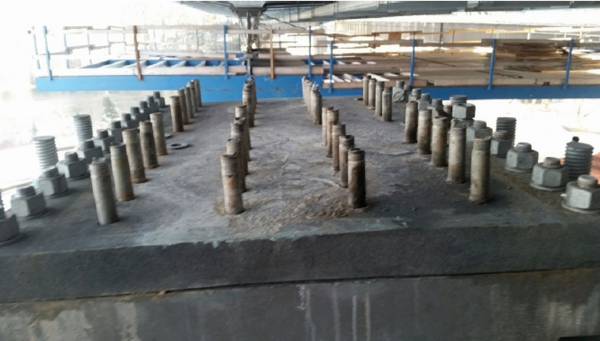
Figure 1-2: Fractured bolts (ASTM A490 bolt – connecting shoe plate to girder flange) and deformed shoe plate at north-west bearing. Note four lines of failed flange connection bolts. (Ministry of Transportation – Nipigon River Bridge Independent Technical Review, by Associated Engineering, September 2016)
The conclusions from the testing of bolts were that the bolts met the requirements and were not the reason for the failure. Examination of the bolt failure surfaces revealed that they had marks consistent with low-cycle high-stress bolt failure. They also noted that corrosion was observed, meaning that the failure was progressive and began prior to January 10, 2016.
Analysis of the bearing revealed that the failure was caused by three factors, which on their own was significant and may have led to a failure but together made “failure inevitable”.
- prying effects due to the flexible shoe plate leading to higher forces in the exterior line of bolts,
- the bearing’s inability to accommodate rotation leading to higher forces in the end rows of bolts,
- the lack of pre-tensioning of the bolts and lack of beveled washers that lead to high fatigue stresses and a high-stress, low-cycle fatigue failure.
The evaluation showed that the shoe plate, bolted connection between shoe plate and girder, bolted connection between shoe plate and bearing, and bearing design all failed to meet the requirements of the Canadian Highway Bridge Design Code (CHBDC).”
The last sentence is damning and contradicts the statement made on January 19th, 2016, “The ministry continues to work with the Ontario Professional Engineers who performed the design of the bridge at WSP (formerly McCormick Rankin Corp in Mississauga), and the Canadian firm that provided additional cable-stayed bridge expertise, Buckland Taylor in British Columbia. The design was performed in accordance with the Canadian Highway Bridge Design Code and is capable of withstanding the necessary Code design parameters for winds in excess of 100 km/h and climatic conditions including freezing temperatures well below -40 degrees celsius.”
Editor’s Note: MMM Group merged with McCormick Rankin Corporation in 2008, and in October of 2015 WSP Global Inc purchased MMM (Marshall Macklin Monaghan Group). Genivar took over London, England’s WSP Group PLC in 2012, then rebranded as WSP Global Inc in January 2014.
The Independent Report prepared by Associated Engineering that considered the design, bearing and bolts concluded:
“The two west abutment bearings supplied had the same design uplift capacities. The north-west bearing failed, while the centre-west bearing did not.
The north-west bearing has higher uplift demands at this stage of construction than the centre-west bearing, but the latter (centre-west bearing) will have approximately double the uplift reaction of the north-west bearing in the completed bridge. These higher loads at the centre girder governed the bearing selection.
That the north-west bearing failed at demands of only half of their maximum design demands illustrates that the bearing assembly’s capacity, as affected by installation, was substantially deficient.
Several conditions at the two bearings that affected bolt tensions and bolt bending could have been sufficiently different that the bolt cracking and fracture propagation had not yet occurred at the center bearing. Bolt polish marks were also observed on the intact bolts of the centre bearing suggesting that it was also experience bolt bending and was prone to a fracture similar to the north-west bearing failure.”
The conclusion made was that the bridge bearing was affected by the installation, and failed, however, the fact that it failed at only half of the designed capacity is disturbing.
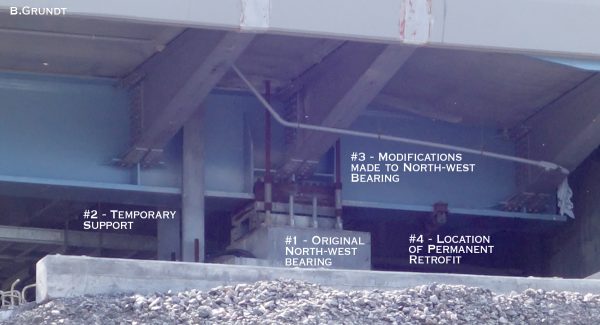
One may note the additional bolts added to the anchor bolts that go through the Masonry Plate. These bolts pierce the bridge deck and are tied similarly to the Temporary Support. The Sole Plate also appears to have an additional piece added that clamps to the bridge girder.
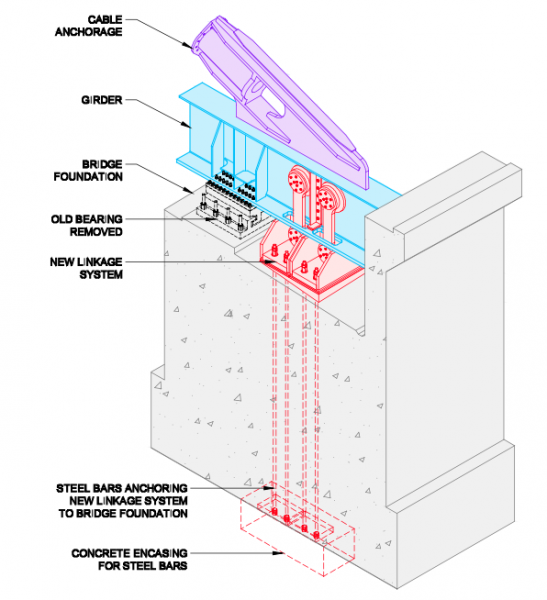
This is the Permanent Retrofit that will take place of the orginal failed bearing, and the temporary tiedown.
In the joint release by Minister Gravelle and Del Duca, Minister of Transportation on September 22, 2016, the following statement was made, “Preliminary estimates for the initial repair work in February and the final repair to be implemented are between $8 and $12 million.”
So… taxpayers have questions, beginning with who is responsible for this error in design? Although one must remember there were faults in the installation process that did play into the failure.
Is it the firm that designed the bearings? The two engineers who stamped the plans, giving their approval? The MTO engineers overseeing the project?
One wonders just how could this design have been approved? How many layers of approval said this was good to go? Who will pay the 8 – 12 million dollars? Will this require a lawsuit to determine blame and recompense?
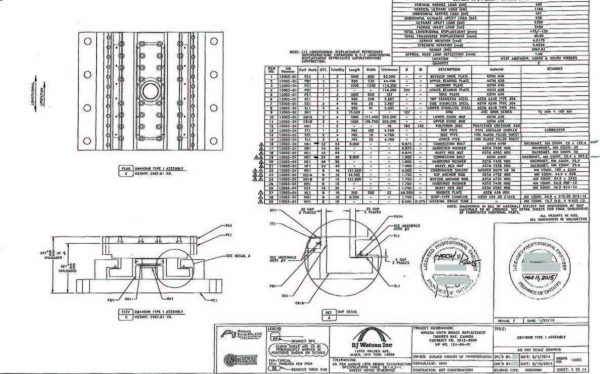
This is a copy of a plan showing a bearing designed for the Nipigon River Bridge. This plan was stamped by two engineers on March 11, 2105, and must be an earlier version of the bearing as there are only 32 bolts holding the sole plate to the girder.
Glen Gower asked similar questions of the Hazeldean Bridge failure, which officially failed because of improper design. He asked, “How and why did a faulty bridge design (actually two faulty bridge designs) get approved in the first place? Has the City made any changes to their procurement and contracting process as a result of this report? “. Delcan investigated the Hazeldean Bridge which was designed by Genivar, now known as WSP Global (2014).
In another bridge failure, Genivar was fired from the Ottawa Airport Parkway Bridge, and as WSP was sued for the costs to repair. Eventually it was determined that the flawed design had been accepted by the City, John Sankey reports “but the $2 million required to fix the Hazeldean bridge was paid for by a settlement involving Genivar, IBI ltGroup and Novatech.”
On October 14th, Professional Engineers of Ontario (PEO) initiated an investigation into the failure. “As a regulator, it’s our responsibility to investigate any possible engineering practice deficiencies related to the failure and determine if engineering work was carried out by appropriately licensed people and companies,” said PEO Registrar Gerard McDonald, P.Eng. “This investigation is consistent with our mandate to govern PEO licence and certificate of authorization holders, and regulate and advance professional engineering practice to protect the public interest.”
However, the public will not know anything unless matters or allegations are referred to the Discipline Committee for hearing, then the discipline proceedings are generally open to the public.
from the MTO website:
Bolt testing reports
- National Research Council Canada “Evaluation of Failed Nipigon River Bridge West Abutment Bolts” – Executive Summary (PDF – 158 KB)
- National Research Council Canada “Evaluation of Failed Nipigon River Bridge West Abutment Bolts” – Full Report (PDF – 15.9 MB)
- Surface Science Western “Report on the Evaluation of the Bolts Provided by MTO” – Executive Summary (PDF – 94.7 KB)
- Surface Science Western “Report on the Evaluation of the Bolts Provided by MTO” – Full Report(PDF – 126 MB)
Investigation reports
- Associated Engineering “Nipigon River Bridge Independent Technical Review” – Executive Summary(PDF – 771 KB)
- Associated Engineering “Nipigon River Bridge Independent Technical Review” – Full Report (PDF – 4.89 MB)
- Ministry of Transportation “Nipigon River Bridge West Abutment Bearing Technical Investigation” – Executive Summary (PDF – 126 KB)
- Ministry of Transportation “Nipigon River Bridge West Abutment Bearing Technical Investigation” – Full Report (PDF – 7.22 MB)
- Note: this report contains large diagrams. Please save this file and open it in Acrobat Reader for best results.
Fact sheets
- Nipigon River Bridge – Bolt Testing Results (PDF – 53 KB)
- Nipigon River Bridge – Investigation (PDF – 1514 KB)
- Nipigon River Bridge – Permanent Retrofit (PDF – 258 KB)
- Monday Morning News – December 15th - December 15, 2025
- Winter Road Conditions – Monday, December 15th - December 15, 2025
- Hwy 17 (Wawa to Batchawana) OPEN - December 14, 2025
 Wawa-news.com You can't hear the 'big picture'!
Wawa-news.com You can't hear the 'big picture'!
